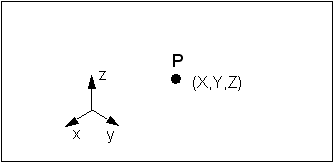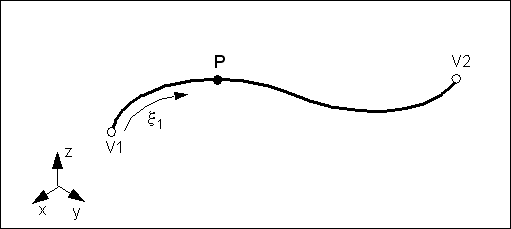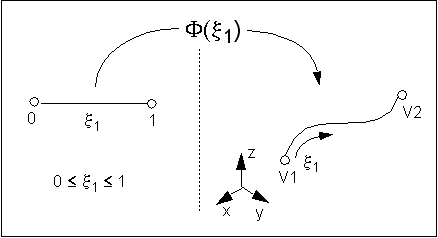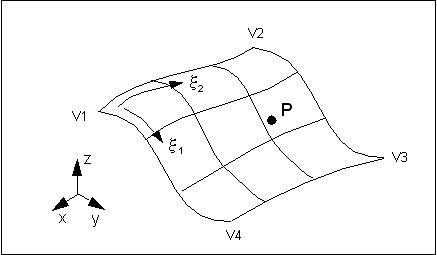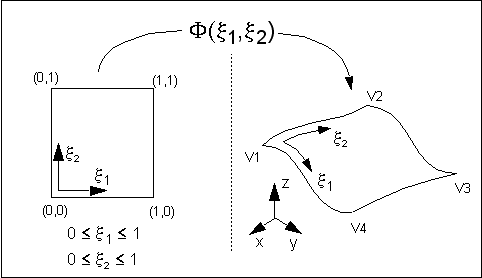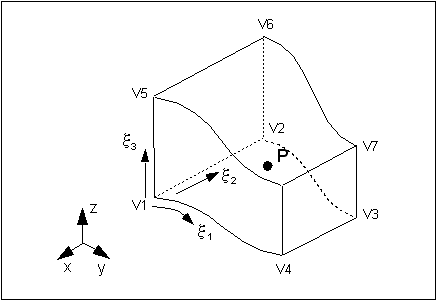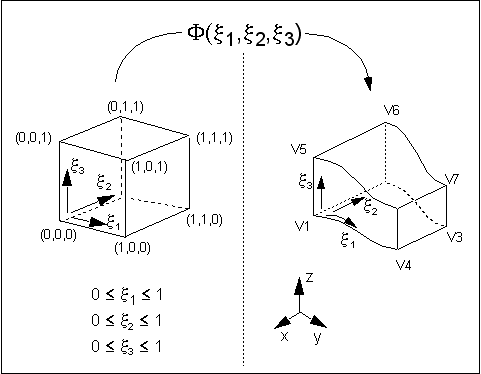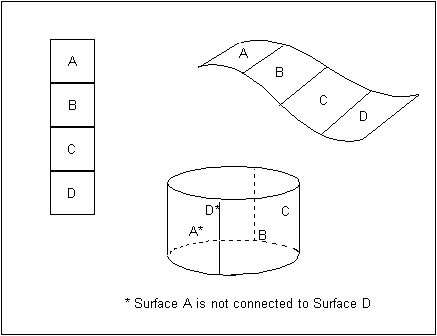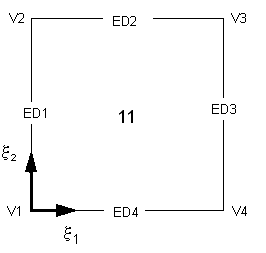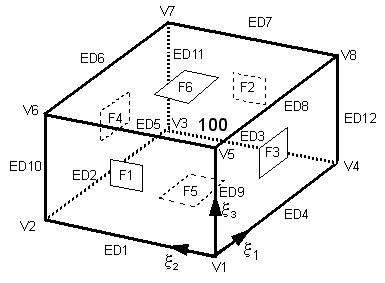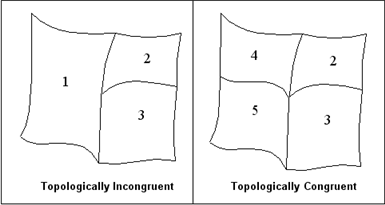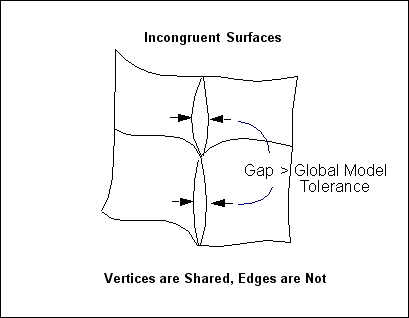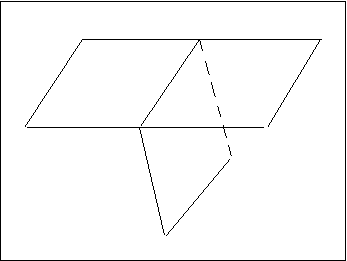XXXXXXXXXXXXXXXXXXXXXXXXXXXXXXXXXXXXXXXXXXXXXXXXXXXXXXXXXXXXXXXXXXXXXXXXXXXXXXXXXXXXXXXXXXXXXXXXXXXXXXXXXXXXXXXXXXXXXXXXXXXXXXXXXXXXXXXXXXXXXXXXXXXXXXXX''"> Concepts and Definitions
There are many functions in Patran that rely on the mathematical representation of the geometry. These functions are:
• Applying a pressure load to a curve, surface or solid.
• Creating a field function in parametric space.
• Meshing a curve, surface or solid.
• Referencing a vertex, edge or face of a curve, surface or solid.
For every curve, surface or solid in a user database, information is stored on its
Parameterization,
Topology and
Connectivity which is used in various Patran functions.
The concepts of parameterization, connectivity and topology are easy to understand and they are important to know when building a geometry and an analysis model.
The following sections will describe each of these concepts and how you can build an optimal geometry model for analysis.
Parameterization
All Patran geometry are labeled one of the following:
• Point (0-Dimensions)
• Curve (1-Dimension)
• Surface (2-Dimensions)
• Solid (3-Dimensions)
Depending on the order of the entity - whether it is a one-dimensional curve, a two-dimensional surface, or a three-dimensional solid - there is one, two or three parameters labeled

,

,

that are associated with the entity. This concept is called “parameterization”.
Parameterization means the X,Y,Z coordinates of a curve, surface or solid are represented as functions of variables or parameters. Depending on the dimension of the entity, the X,Y,Z locations are functions of the parameters

,

, and

.
An analogy to the parameterization of geometry is describing an

,

location as a function of time,

t. If

and

, as

changes,

and

will define a path. Parameterization of geometry does the same thing - as the parameters

,

, and

change, it defines various points on the curve, surface and solid.
The following describes how a point, curve, surface and solid are parameterized in Patran.
Point
A Point in Patran is a point coordinate location in three-dimensional global XYZ space.
Since a point has zero-dimensions, it has no associated parameters, therefore, it is not parameterized.
Figure 1‑1 Point in Patran
Curve
A Curve in Patran is a one-dimensional point set in three-dimensional global XYZ space. A curve can also be described as a particle moving along a defined path in space.
Another way of defining a curve is, a curve is a mapping function,

, from one-dimensional parametric space into three-dimensional global XYZ space, as shown in
Figure 1‑3.
A curve has one parametric variable,

, which is used to describe the location of any given point,

, along a curve, as shown in
Figure 1‑2.
Figure 1‑2 Curve in Patran
The parameter,

, has a range of

, where at

,

is at endpoint

and at

,

is at endpoint

.
A straight curve can be defined as:
(1‑1)

Figure 1‑3 Mapping Function Phi for a Curve
(1‑1) of our straight curve can be represented as:
(1‑2)

The derivative of

in
(1‑2), would give us
(1‑3) which is the tangent of the straight curve.
(1‑3)

Because the curve is straight,

is a constant value. The tangent,

, also defines a vector for the curve, which is the positive direction of

.
For any given curve, the tangent and positive direction of

at any point along the curve can be found. (The vector,

, usually will not have a length of one.)
Surface
A surface in Patran is a two-dimensional point set in three-dimensional global XYZ space.
A surface has two parameters,

and

, where at any given point,

, on the surface,

can be located by

and

, as shown in
Figure 1‑4.
Figure 1‑4 Surface in Patran
A surface generally has three or four edges. Trimmed surfaces can have more than four edges. For more information, see
Trimmed Surfaces, 20.
Similar to a curve,

and

for a surface have ranges of

and

. Thus, at

,

,

is at

and at

,

,

is at

.
A surface is represented by a mapping function,

, which maps the parametric space into the global XYZ space, as shown in
Figure 1‑5.
Figure 1‑5 Mapping Function Phi for a Surface
The first order derivatives of

results in two partial derivatives,

and

:
(1‑4)

where

is the tangent vector in the

direction and

is the tangent vector in the

direction.
At any point for a given surface,

and

which define the tangents and the positive

and

directions can be determined.
Usually

and

are not orthonormal, which means they do not have a length of one and they are not perpendicular to each other.
Solid
A solid in Patran is a three-dimensional point set in three-dimensional global XYZ space.
A solid has three parameters,

,

, and

, where at any given point,

, within the solid,

can be located by

,

, and

, as shown in
Figure 1‑6.
Note: | Note: The above definition applies to tri-parametric solids only. Patran can also create or import a B-rep solid, which is parameterized on the outer surface only, and not within the interior. See B-rep Solid, 24 for more information. |
Figure 1‑6 Solid in Patran
A solid generally has five or six sides or faces. (A B-rep solid can have more than six faces.)
The parameters

,

and

have ranges of

,

, and

. At (0,0,0)

is at

and at (1,1,1),

is at

.
A solid can be represented by a mapping function,

, which maps the parametric space into the global XYZ space, as shown in
Figure 1‑7.
Figure 1‑7 Mapping Function Phi for a Solid
If we take the first order derivatives of

, we get three partial derivatives,

,

and

, shown in
(1‑5):
(1‑5)

Where

is the tangent vector in the

direction,

is the tangent vector in the

direction, and

is the tangent vector in the

direction.
At any point within a given solid,
 ,
, 
and

, which define the tangents and positive

,

and

directions can be determined.
Topology
Topology identifies the kinds of items used to define adjacency relationships between geometric entities.
Every curve, surface and solid in Patran has a defined set of topologic entities. You can reference these entities when you build the geometry or analysis model. Examples of this include:
• Creating a surface between edges of two surfaces.
• Meshing an edge or a face of a solid.
• Referencing a vertex of a curve, surface or solid to apply a loads/BC.
Topology is invariant through a one-to-one bicontinuous mapping transformation. This means you can have two curves, surfaces or solids that have different parameterizations, but topologically, they can be identical.
To illustrate this concept,
Figure 1‑8 shows three groups of surfaces A-D. Geometrically, they are different, but topologically they are the same.
Figure 1‑8 Topologically Equivalent Surfaces
Topologic Entities: Vertex, Edge, Face, Body
The types of topologic entities found in Patran are the following:
Vertex | Defines the topologic endpoint of a curve, or a corner of a surface or a solid. A vertex is separate from a geometric point, although a point can exist on a vertex. |
Edge | Defines the topologic curve on a surface or a solid. An edge is separate from a geometric curve, although a curve can exist on an edge. |
Face | Defines the topologic surface of a solid. A face is separate from a geometric surface, although a surface can exist on a face. |
Body | A group of surfaces that forms a closed volume. A body is usually referenced as a B-rep solid or a Volume solid, where only its exterior surfaces are parameterized. See Solids, 24 for more information. |
Vertex, Edge and Face ID Assignments in Patran
The connectivity for a curve, surface and solid determines the order in which the internal vertex, edge and face IDs will be assigned. The location of a geometric entity’s parametric axes defines the point where assignment of the IDs for the entity’s vertices, edges and faces will begin.
Important: | Generally, when modeling in Patran, you do not need to know the topologic entities’ internal IDs. When you cursor select a topologic entity, such as an edge of a surface, the ID will be displayed in the appropriate listbox on the form. |
Figure 1‑9 and
Figure 1‑10 show a four sided surface and a six sided solid with the internal vertex, edge and face IDs displayed. If the connectivity changes, then the IDs of the vertices, edges and faces will also change.
Figure 1‑9 Vertex & Edge Numbering for a Surface
Figure 1‑10 Face Numbering for a Solid
For example, in
Figure 1‑9, the edge, ED3, of Surface 11 would be displayed as:
Surface 11.3
The vertex, V4, in
Figure 1‑9 would be displayed as:
Surface 11.3.1
V4 has a vertex ID of 1 that belongs to edge 3 on surface 11.
The face, F1, of Solid 100 in
Figure 1‑9 would be displayed as:
Solid 100.1
The edge, ED10, in
Figure 1‑10 would be displayed as:
Solid 100.1.3
ED10 has an edge ID of 3 that belongs to face 1 on solid 100.
The vertex, V6, in
Figure 1‑10 would be displayed as:
Solid 100.1.2.2
V6 has a vertex ID of 2 that belongs to edge 2 on face 1 on solid 100.
Topological Congruency and Meshing
When meshing adjacent surfaces or solids, Patran requires the geometry be topologically congruent so that coincident nodes will be created along the common boundaries.
Figure 1‑11 shows an example where surfaces 1 through 3 are topologically incongruent and surfaces 2 through 5 are topologically
congruent. The outer vertices are shared for surfaces 1 through 3, but the inside edges are not. Surfaces 2 through 5 all have common edges, as well as common vertices.
There are several ways to correct surfaces 1 through 3 to make them congruent. See
Building a Congruent Model for more information.
Figure 1‑11 Topologically Incongruent and Congruent Surfaces
For a group of surfaces or solids to be congruent, the adjacent surfaces or solids must share common edges, as well as common vertices.
(MSC.Software Corporation’s Patran software product required adjacent surfaces or solids to share only the common vertices to be considered topologically congruent for meshing.)
Gaps Between Adjacent Surfaces
Another type of topological incongruence is shown in
Figure 1‑12. It shows a gap between two pairs of surfaces that is greater than the
Global Model Tolerance. This means when you mesh the surface pairs, coincident nodes will not be created along both sides of the gap.
Figure 1‑12 Topologically Incongruent Surfaces with a Gap
MSC recommends two methods for closing surface gaps:
Non-manifold Topology
Non-manifold topology can be simply defined as a geometry that is non-manufacturable. However, in analysis, non-manifold topology is sometimes either necessary or desirable.
Figure 1‑13 shows a surface model with a non-manifold edge.
Figure 1‑13 Non-manifold Topology at an Edge
This case may be perfectly fine. A non-manifold edge has more than two surfaces or solid faces connected to it. Therefore, two solids which share a common face also give non-manifold geometry (both the common face and its edges are non-manifold).
In general, non-manifold topology is acceptable in Patran. The exception is in the creation of a B-rep solid where a non-manifold edge is not allowed. The
Verifying Surface Boundaries option detects non-manifold edges as well as free edges.
Connectivity
In
Figure 1‑2,
Figure 1‑4, and
Figure 1‑6 in
Parameterization, the axes for the parameters,

,

, and

, have a unique orientation and location on the curve, surface and solid.
Depending on the orientation and location of the

,

, and

axes, this defines a unique
connectivity for the curve, surface or solid.
For example, although the following two curves are identical, the connectivity is different for each curve (note that the vertex IDs are reversed):
Figure 1‑14 Connectivity Possibilities for a Curve
For a four sided surface, there are a total of eight possible connectivity definitions. Two possible connectivities are shown in
Figure 1‑15. (Again, notice that the vertex and edge IDs are different for each surface.)
Figure 1‑15 Two Possible Connectivities for a Surface
For a tri-parametric solid with six faces, there are a total of 24 possible connectivity definitions in Patran - three orientations at each of the eight vertices. Two possible connectivities are shown in
Figure 1‑16.
Figure 1‑16 Two Possible Connectivities for a Solid
Plotting the Parametric Axes
Patran can plot the location and orientation of the parametric axes for the geometric entities by turning on the Parametric Direction toggle on the Geometric Properties form, under the Display/Display Properties/Geometric menu. See
Preferences>Geometry (p. 467) in the Patran Reference Manual for more information.
Modifying the Connectivity
For most geometric entities, you can modify the connectivity by altering the orientation and/or location of the parametric axes by using the Geometry application’s Edit action’s Reverse method. See
Overview of the Edit Action Methods.
For solids, you can also control the location of the parametric origin under the Preferences/Geometry menu and choose either the Patran Convention button or the PATRAN 2.5 Convention button for the Solid Origin Location.
Effects of Parameterization, Connectivity and Topology in Patran
The geometry’s parameterization and connectivity affect the geometry and finite element analysis model in the following ways:
Defines Order of Internal Topologic IDs
The parameterization and connectivity for a curve, surface or solid define the order of the internal IDs of their topologic entities. Patran stores these IDs internally and displays them when you cursor select a vertex, edge or face. See
Vertex, Edge and Face ID Assignments in Patran for more information.
Defines Positive Surface Normals
Using right hand rule by crossing a surface’s

direction with its

direction, it defines the surface’s positive normal direction (

direction). This affects many areas of geometry and finite element creation, including creating B-rep solids. See
Building An Optimal Geometry Model for more information.
Defines Positive Pressure Load Directions
The parameterization and connectivity of a curve, surface or solid define the positive direction for a pressure load, and it defines the surface’s top and bottom locations for an element variable pressure load. See
Create Structural LBCs Sets (p. 21) in the Patran Reference Manual for more information.
Helps Define Parametric Field Functions
If you reference a field function that was defined in parametric space, when creating a varying loads/BC or a varying element or material property, the loads/BC values or the property values will depend on the geometry’s parameterization and the orientation of the parametric axes. See
Fields Forms (p. 204) in the Patran Reference Manual for more information.
Defines Node and Element ID Order For IsoMesh
The Patran mapped mesher, IsoMesh, will use the geometric entity’s parameterization and connectivity to define the order of the node and element IDs and the element connectivity. (The parameterization and connectivity will not be used if the mesh will have a transition or change in the number of elements within the surface or solid.) See
IsoMesh (p. 13) in the Reference Manual - Part III for more information.
Global Model Tolerance & Geometry
Patran uses the Global Model Tolerance when it imports or accesses geometry, when it creates geometry, or when it modifies existing geometry.
The Global Model Tolerance is found under the Preferences/Global menu. The default value is 0.005.
When creating geometry, if two points are within a distance of the Global Model Tolerance, then Patran will only create the first point and not the second.
This rule also applies to curves, surfaces and solids. If the points that describe two curves, surfaces or solids are within a distance of the Global Model Tolerance, then only the first curve, surface or solid will be created, and not the second.
Important: | For models with dimensions which vary significantly from 10 units, MSC recommends you set the Global Model Tolerance to .05% of the maximum model dimension. |
For more information on the Global Model Tolerance, see
(p. 73) in the Patran Reference Manual.
